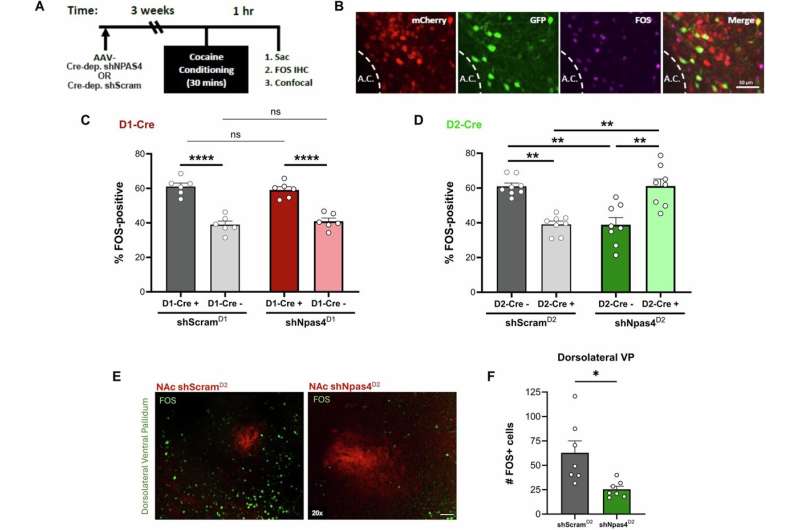This article has been reviewed according to Science X's editorial process and policies. Editors have highlighted the following attributes while ensuring the content's credibility:
fact-checked
peer-reviewed publication
trusted source
proofread
Key factor found in drug-context links, relapse

Most people wouldn't think twice after seeing sugar spilled on a counter. But for someone with a history of cocaine use, this visual cue could trigger powerful associations with their past drug use and a compulsive urge to seek the drug.
Certain circuits within the brain help to form natural associations between one's experiences and the context in which those experiences occur. These associations play a critical role in the orchestration of adaptive learning.
When addictive substances are introduced, this coupling mechanism can be hijacked so that the drug-taking behavior becomes associated with cues, such as people, places or situations, linked to the drug experience. These drug-context associations become critical factors that contribute to one's relapse vulnerability.
In a recent publication in Nature Communications, a research team at the Medical University of South Carolina (MUSC) led by Department of Neuroscience chairman Christopher Cowan, Ph.D., identified a mechanism by which these drug-context associations are regulated by a small population of cells in the nucleus accumbens.
The nucleus accumbens is where drug-dependent dopamine increases are associated with their rewarding effects. The MUSC team sought to understand how a regulatory factor, neuronal PAS domain protein 4, or NPAS4, controls the formation and maintenance of drug-context associations. This study also revealed how NPAS4 affects future drug-taking using a mouse model.
"These drug-context associations become future triggers for drug seeking," explained Cowan, highlighting why it's important that scientists understand how these associations are formed.
The MUSC team included former graduate student Brandon Hughes, Ph.D., current postdoctoral fellow Jessica Huebschman, Ph.D., and Makoto Taniguchi, Ph.D., an assistant professor in the Department of Neuroscience.
For individuals with a substance use disorder, experiencing a context or certain cues that remind them of drug use can hinder abstinence and promote a return to active drug use.
The MUSC researchers identified a small group of cells within the nucleus accumbens that appear essential for drug-context associations. They found that the percentage of these NPAS4-expressing neurons increased when exposed to cocaine.
NPAS4 is a transcription factor that helps to regulate how a cell responds to neuronal activity induced by various stimuli, including drugs. The MUSC team looked specifically at NPAS4 in the nucleus accumbens because this region is known to regulate motivation and reward-associated learning.
After identifying this small population of neurons that expressed NPAS4 in response to cocaine, the researchers investigated the behavioral effects of inhibiting these neurons. Without the activity of these cells, mice no longer displayed drug-seeking behavior when put in the context they associated with cocaine.
"NPAS4 is a molecule in the brain that is trying very hard to keep systems functioning as normally as possible," said Cowan. "But drugs are tapping into this and using it to their advantage."
Next, the team wanted to understand how NPAS4 helps to form drug-context associations. To do so, they looked at NPAS4 within the two major types of cells in the nucleus accumbens—D1 and D2 dopamine receptor-expressing neurons. Dopamine, a major neurotransmitter in the brain, plays a crucial role in reward-associated learning.
"Classically, D1 neurons tend to promote drug-seeking behavior, while D2 neurons tend to oppose it," explained Cowan. "So, it's a bit of a Yin and Yang, a push and the pull, of this motivational circuit. When an animal encounters a drug-associated context, it's going to activate D1 and D2, but D1 typically wins."
Surprisingly, the study showed that NPAS4 in D2 neurons, but not D1, is necessary for context-associated drug seeking. At first, this finding appeared somewhat counterintuitive, said Cowan. How can this protein promote drug-seeking behavior by acting in the cells that typically oppose it?
"Drugs are presumably doing multiple things," said Cowan. "Obviously, they're strengthening and forming the context memory, but they're also suppressing the ability of the brain to oppose this association."
If D2 neurons act as a brake for drug taking, NPAS4 effectively weakens those brakes. As a result, drug-context associations are strengthened, and the likelihood of further drug-seeking behaviors may increase.
If researchers can better understand the factors contributing to drug-context associations, they will be able to identify new therapeutic targets to reduce a return to drug use.
"Ultimately, the long-range goal is to understand how NPAS4 mediates these effects to aid in the design of potential therapeutics," explained Cowan.
More information: Brandon W. Hughes et al, NPAS4 supports cocaine-conditioned cues in rodents by controlling the cell type-specific activation balance in the nucleus accumbens, Nature Communications (2024). DOI: 10.1038/s41467-024-50099-1



















